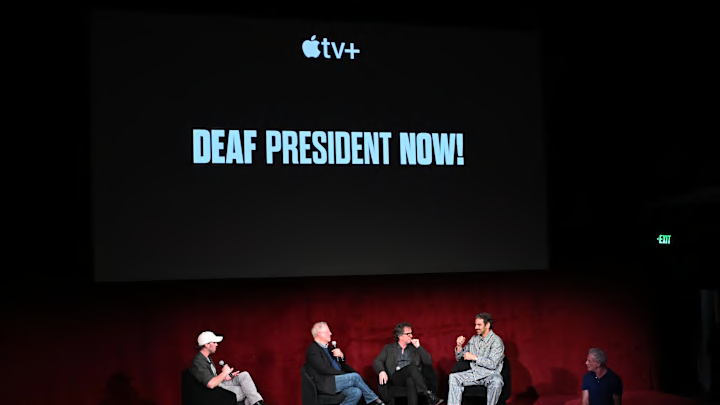In March 1988, Gallaudet University in Washington, D.C., the biggest deaf-exclusive college in the world, announced its new university president. Despite a pair of deaf candidates being up for the job, Gallaudet's Board of Trustees chose hearing candidate Elisabeth Zinser for the job. It was a tremendous blow to the institution's student body, who'd always struggled with feeling like Gallaudet’s leadership didn’t represent their points of view. These students were not going to take this lying down. It was time to take to the streets and protest this egregious development.
Directors Davis Guggenheim (a veteran of helming socially conscious documentaries like He Named Me Malala and An Inconvenient Truth) and Nyle DiMarco (a Gallaudet veteran) frame Deaf President Now! primarily through archival footage, a smattering of newly-shot recreation imagery, and especially first-hand interviews with the protestors who made this movement possible. The outspoken Jerry Covell, thoughtful strategist, Bridgetta Bourne-Firl, Gallaudet staff member I. King Jordan, and public face of the protest Greg Hilbok are among those who guide viewers through a week where Gallaudet’s students championed their humanity.
Deaf President Now!’s best moments have a subversive, anarchic verve. A great example of this is the recurring of the campus’s fire alarms to either communicate important info to fellow Gallaudet students or disrupt speeches from hearing folks. Scenes of Hilbok and other students standing their ground in the face of pushy, dismissive staff members similarly radiate living on the edge and challenging authority. This atmosphere especially materializes in news footage of the Gallaudet students being understandably enraged the night Zinser clinched her presidential job. Between the crusty camerawork and the unfiltered responses from the college-aged interview subjects, engagingly unpolished frustration emerges.
The dismissal of deaf humanity (right down to a hearing person allegedly proclaiming that a deaf candidate couldn’t “handle” the job) doesn’t inspire tidy soliloquies about societal oppression. This devastating development hits a raw nerve that the candid, jagged camerawork of local news teams captures viscerally. Confining this narrative to just a week, meanwhile, also keeps the tension palpable. Guggenheim and DiMarco’s restrained scope ensures Deaf President Now! doesn’t get too cluttered for its own good. A streamlined canvas lets the compelling interview segments and tremendous historical “twists” have more impact.
Still, Deaf President Now! needed some extra messiness and grit to its story I noted that (save for the occasional Killers of the Flower Moon or that Beastie Boys documentary from Todd Haynes), most Apple TV+ movies are sanitized enough that they can play in Apple store without ever jarring customers. This streamer’s non-Scorsese/Haynes works don’t have time for sex, drugs, extreme profanity, or anything too aggressive. Deaf President Now! wasn’t developed in-house by the Apple Original Films team. They merely acquired it five months ago. Yet it’s easy to see why this is the documentary on disability advocacy Apple TV+ would gravitate towards.
Nearly everything in Deaf President Now! is kept strictly PG while more distressing on an artistic level is that the push for civil rights is depicted in a clean, linear path always swinging towards progressivism. Any of the nuanced realities for marginalized communities (where one decade can see progress while the next era see’s civil rights rolled back) that’re common place in All the Beauty and the Bloodshed are absent in Deaf President Now! Meanwhile, messier aspects of the revolt against ableism are only briefly flirted with. As Bridgetta is introduced, it’s noted that her male cohorts constantly expressed annoyance with her always bringing up “women’s rights”.
There’s an interesting idea there about the struggles of intersectional politics within marginalized activism. However, this jagged corner of Bridgetta’s presence or anything related to gender is never brought up again. The concept of race is only noted in a closing sequence where a white interview subject recalls Black onlookers cheering on Gallaudet's students protesting in the streets. No documentary can cover every topic. A movie is not subpar simply because it doesn’t deliver feminist theory so insightful it would make bell hooks or Octavia Butler leap out of their seats to cheer.
However, Deaf President Now!’s inability to grapple with larger intersectional questions, not to mention its straightforward tidy approach to depicting activism, does rob it of some of its powers. Inevitably, the surface-level qualities that undoubtedly got Apple’s interest also ensure Guggenheim and DiMarco’s documentary is no Harlan County U.S.A. Disposably realized forms of recreation footage simply compound the generic ambiance wrapped around this production.
Thankfully, Deaf President Now! still houses great and lively anecdotes from Gallaudet alumni. While the documentaries visual scheme and approach to politics is familiar, Deaf President’s stories and interview subjects are divinely idiosyncratic. A brief detour into harrowing testimony from Bridgetta and Jerry about their respective childhoods are especially stirring. Bridgetta, for instance, was the face of a horrific initiative that sought to “fix” deaf children. Jerry, meanwhile, had a deaf father who nonchalantly accepted his co-workers forcing him into a basement work station away from the outside world.
In these narratives, rife with memorable language and vivid vulnerability, one fully grasps how the central protest at the heart of Deaf President Now! didn’t just start with Zinser’s election. This development was the culmination of decades of dehumanization and infantilizing. The status quo could not stand. When there’s a fire in Deaf President Now!’s belly, like in these powerful interview segments, this feature comes alive as a testament to working-class activism. Unfortunately, its rudimentary execution undercuts those greater flourishes.
